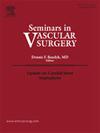The role of flaps in preventing lower extremity amputations
IF 2.4
3区 医学
Q1 PERIPHERAL VASCULAR DISEASE
引用次数: 0
Abstract
The increasing prevalence of chronic limb-threatening ischemia and diabetes mellitus has led to a surge in lower extremity amputations, driven by the combination of peripheral arterial disease and extensive wounds. Although revascularization often addresses ischemia, severe wounds pose a significant risk of amputation. Flaps, which involve the transfer of vascularized tissue, can provide immediate closure of complex wounds, particularly those involving bone or tendon exposure, where skin grafts are insufficient. Flap reconstruction of wounds can prevent amputation in cases when revascularization alone would not, but these complex efforts require close collaboration between vascular and plastic surgeons. Despite their potential to prevent amputations, flaps are underused in vascular surgery due to limited availability and expertise, particularly in complex cases involving diabetes and peripheral vascular disease. There are also socioeconomic and reimbursement challenges that limit interest on the part of plastic surgeons. This article explores the principles, techniques, and challenges of flap reconstruction in lower extremity limb salvage, emphasizing the need for multidisciplinary care.
皮瓣在预防下肢截肢中的作用
慢性肢体威胁缺血和糖尿病的患病率日益增加,导致下肢截肢的激增,这是由外周动脉疾病和大面积伤口共同驱动的。虽然血运重建术经常解决缺血问题,但严重的伤口会造成截肢的重大风险。皮瓣涉及血管化组织的转移,可以立即关闭复杂的伤口,特别是那些涉及骨或肌腱暴露的伤口,皮肤移植是不够的。在单纯血运重建术无法避免截肢的情况下,皮瓣重建伤口可以避免截肢,但这些复杂的努力需要血管外科医生和整形外科医生之间的密切合作。尽管皮瓣具有预防截肢的潜力,但由于可用性和专业知识有限,特别是在涉及糖尿病和周围血管疾病的复杂病例中,皮瓣在血管手术中的应用不足。此外,社会经济和报销方面的问题也限制了整形外科医生的兴趣。本文探讨了残肢残肢皮瓣重建的原理、技术和挑战,强调了多学科治疗的必要性。
本文章由计算机程序翻译,如有差异,请以英文原文为准。
求助全文
约1分钟内获得全文
求助全文
来源期刊
CiteScore
3.50
自引率
4.00%
发文量
54
审稿时长
50 days
期刊介绍:
Each issue of Seminars in Vascular Surgery examines the latest thinking on a particular clinical problem and features new diagnostic and operative techniques. The journal allows practitioners to expand their capabilities and to keep pace with the most rapidly evolving areas of surgery.

 求助内容:
求助内容: 应助结果提醒方式:
应助结果提醒方式:


